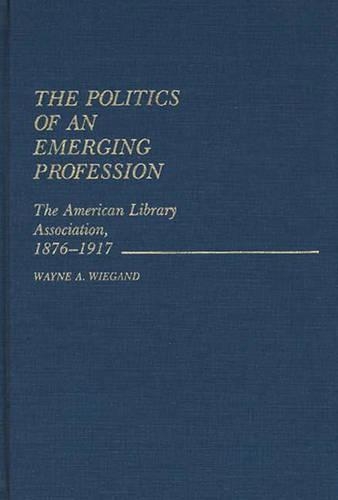
The Politics of an Emerging Profession: The American Library Association, 1876-1917
(Hardback)
Publishing Details
The Politics of an Emerging Profession: The American Library Association, 1876-1917
Bloomsbury Publishing PLC
Praeger Publishers Inc
26th March 1986
United States
Classifications
Tertiary Education
Non Fiction
020.62273
Physical Properties
Hardback
331
Width 156mm, Height 235mm
680g
Description
Wiegand examines the development of ALA from 1876 to 1917 in this masterful tale. He looks at the issues that existed during those years, the conflicts, and the changing characteristics of ALA's Executive Board, and succeeds in giving us a particularly revealing picture of the nature of the profession. He analyzes the three elements of Dewey's motto, `The best reading for the largest number at the least cost,' and how they characterized ALA's development as the leaders sought to accomplish those goals. Wiegand makes his points carefully in this story of a `struggle to accommodate shifting pressures and power groups within the world of librarianship. This is a perceptive, reliable recounting of our early history, and will stimulate a great deal of discussion. Wiegand's book deserves a wide audience. Wilson Library Bulletin
Reviews
"Wiegand examines the development of ALA from 1876 to 1917 in this masterful tale. He looks at the issues that existed during those years, the conflicts, and the changing characteristics of ALA's Executive Board, and succeeds in giving us a particularly revealing picture of the nature of the profession. He analyzes the three elements of Dewey's motto, The best reading for the largest number at the least cost, ' and how they characterized ALA's development as the leaders sought to accomplish those goals. Wiegand makes his points carefully in this story of a struggle to accommodate shifting pressures and power groups within the world of librarianship." This is a perceptive, reliable recounting of our early history, and will stimulate a great deal of discussion. Wiegand's book deserves a wide audience.-Wilson Library Bulletin
The American Library Association is the oldest, largest, and strongest library association in the world. Wiegand, well known for his historical writings, discusses the first 41 years of ALA in this book. The study treats the development of the association from its establishment in Philadelphia in 1876, and the contributions of many librarians, including R.R. Bowker, Charles Cutter, Melville Dewey, William Frederick Poole and Justin Winsor. The author shows the early problems of ALA, threats to split the association, tensions and fights among the leaders, and finally how stability was achieved in 1917. The birth of special groups, such as the College and Reference Section, the Trustees Section, the Association of American Library Schools, and various round tables, is also mentioned. The interesting debate on the selection of Chicago as the permanent ALA headquarters in 1909, the powers of the five-member executive board, and other developments are discussed. In spite of its achievements and stability, there was discrimination in ALA against blacks and women during this period. The book includes a useful bibliography of primary and secondary sources, a collective profile of changing characteristics of ALA executive board members, lists of all presidents and conference sites, and a record of attendence in all annual conferences. This is an excellent book for all librarians, library educators, students, and others interested in the history of ALA.-Choice
""Wiegand examines the development of ALA from 1876 to 1917 in this masterful tale. He looks at the issues that existed during those years, the conflicts, and the changing characteristics of ALA's Executive Board, and succeeds in giving us a particularly revealing picture of the nature of the profession. He analyzes the three elements of Dewey's motto, The best reading for the largest number at the least cost, ' and how they characterized ALA's development as the leaders sought to accomplish those goals. Wiegand makes his points carefully in this story of a struggle to accommodate shifting pressures and power groups within the world of librarianship." This is a perceptive, reliable recounting of our early history, and will stimulate a great deal of discussion. Wiegand's book deserves a wide audience."-Wilson Library Bulletin
"The American Library Association is the oldest, largest, and strongest library association in the world. Wiegand, well known for his historical writings, discusses the first 41 years of ALA in this book. The study treats the development of the association from its establishment in Philadelphia in 1876, and the contributions of many librarians, including R.R. Bowker, Charles Cutter, Melville Dewey, William Frederick Poole and Justin Winsor. The author shows the early problems of ALA, threats to split the association, tensions and fights among the leaders, and finally how stability was achieved in 1917. The birth of special groups, such as the College and Reference Section, the Trustees Section, the Association of American Library Schools, and various round tables, is also mentioned. The interesting debate on the selection of Chicago as the permanent ALA headquarters in 1909, the powers of the five-member executive board, and other developments are discussed. In spite of its achievements and stability, there was discrimination in ALA against blacks and women during this period. The book includes a useful bibliography of primary and secondary sources, a collective profile of changing characteristics of ALA executive board members, lists of all presidents and conference sites, and a record of attendence in all annual conferences. This is an excellent book for all librarians, library educators, students, and others interested in the history of ALA."-Choice
Author Bio
egand /f Wayne /i A.
